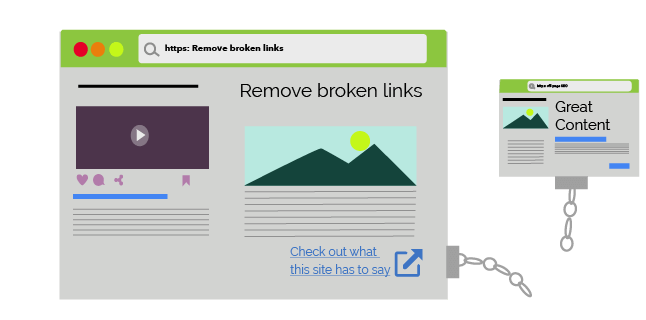Do you ever think about how you could improve your rankings, without harming your visitor’s site experience?
SEO is a long-term strategy which requires a lot of time and patience before you see noticeable results.
But, it can take a lot of research and time to create high-quality content for your website.
Then, you need to wait for search engines to index your new content. Which means you could wait months before you see the impact of your work.
What about your old content?
Why not review your old pages, which have already been indexed by Google? Doing so could impact your rankings without the long wait.
A quick refresh of your published content can increase the effectiveness of keywords you already rank for. This means you can easily boost your site traffic, without having to produce new content or wait.
Google prioritises fresh content
Search engines such as Google tend to rank fresh content higher than out-dated material. New content is considered more relevant to the searcher.
In fact, Google have even publicly stated that 35% of people’s searches are influenced by this ‘freshness’ algorithm update.
If you refresh your old content, you can make it more relevant to the user. Which, in a matter of days or weeks, could result in your page to climb up several ranking positions. 
Remember, fresh content doesn’t always mean better rankings
Search engines like Google are very complex. Your website’s rankings are based on a variety of off-page and on-page factors, not just the freshness of your content.
Relevance, click-through rates and backlinking all play a part in determining the quality of your content. Never assume that your content will automatically increase your page rankings after an update.
Remember, search engines are all about connecting searchers to content that’s relevant and best answers their query. So, always should prioritise your content. Make sure it’s the best possible content it can be to fulfil your searcher’s intent.
How to choose which content to update
When you plan to refresh content, the first step is to decide which pages could benefit from having a refresh.
To do this, you can use Google Webmaster tools. Or alternatively, other SEO software you may have purchased for your website.
These tools usually allow you to view your search analytics. And, more specifically, the current positions for each of your pages.
90% of searchers never scroll past page one of their search engine results pages (SERPs). Therefore, start by working on pages which rank in positions 10-30 on Google (page two or three on Google search).

If you can, refresh this content and try to move it to page one.
This is the quickest way to increase your overall website visibility and traffic.
5 Ways To Update Your Content To Improve SEO
There are five things you can do to update your content and improve your SEO, including:
- Adding and revamping your content
- Reviewing your keywords
- Updating your meta information
- Removing any broken links
Let’s take a look at each of these in more detail.
1. Adding more content
With search engines ranking the most suitable content at the top of their SERPs, it seems obvious that adding more content to your pages can help.
In fact, research has found that the more words a piece of content has, the higher it will rank on a page of SERPs.
Of course this doesn’t mean that you should simply throw words onto a page in order to try and rank. But it does mean that if you increase the richness and quality of the content and include more relevant and up-to-date information, then you could improve your chances of ranking higher.

But how much more is enough?
Well, there’s no one size fits all when it comes to the length of your content.
The average page ranked in position one typically has 2,416 words, while the tenth results has an average of 2,032 words.
But, the number of words on a page doesn’t necessarily correlate to your success.
So, the question you should ask yourself is ‘how much is enough to add value?’
Make sure your content includes enough information to completely fulfil what your searcher is looking for, without being overwhelming.
You’ll also want to ensure that any content you refresh removes all outdated information. Replace it with the most up-to-date information, so your brand is seen as relevant and competitive.
It’s all about reviewing your pages and updating them to be the most purposeful and relevant to a searcher’s query.
So, if you add more new content to your pages, only do it because it adds value.
2. Revamping your content
At the start of any marketing strategy, businesses can sometimes get caught up in trying to produce lots of content. They forget that the content they produce is meant to be useful for human beings.
And so, one of the best ways to improve your search engine rankings is to improve its overall appearance.
Content today can take almost any format – photos, infographics, videos, audio files, etc. Therefore, it doesn’t have to be as simple as just having text on a page.

Mix it up
Of course long text-based content is still extremely valuable for your site’s SEO. But, ensure you break up its appearance with visual or audio media to improve the user’s overall experience.
As a general rule of thumb, you should use a visual for every 350 words of text. A visual can take the form of photos, videos or illustrations. Visuals should be relevant, high-quality and include a link back to their original source (unless it is your own media).
Review the appearance of your content to include new types of media. This can help to make it more engaging. And, it can increase the likelihood of other people linking to it, which will improve your rankings on SERPs.
3. Keyword review
Keyword research is the crux of any on-page SEO. It forms the basis of lots of decisions we make when creating a content plan.
As part of any good SEO strategy, you should always review your keywords. Ensure the ones included in your content match the ones in your target audience’s search query.
As markets and industries grow and change, so do the things we as consumers search for.
Your keyword content plan should never be set in stone. It’s a living, breathing piece of research to be constantly reviewed to make sure it’s as relevant as it can be.
Make sure you take the time to regularly review your keywords
That way, you won’t miss when new long-tail keywords or phrases become popular search terms.

Don’t remove your focus on old keywords which are ranking already. This could cause some volatility to your rankings.
However, include a few more relevant long-tail keywords to your content to increase your rankings for different search terms. This will improve your overall SEO rank.
4. Updating meta information
Off-page SEO can have as great an impact on your rankings as the content that’s on your pages.
Just one example includes click-through rates, which can have a great impact on your page’s rankings.
And so, when you update any old content, make sure to review your off-page meta information for maximum impact. This will make your content more clickable.
A good place to start when reviewing your meta information is to compare it to your competitors. This can easily be done by typing in the search query that you rank for then comparing your title and description to theirs.
Which one provides more context for the keyword searched for? And which one sounds the most enticing?
The most successful meta information has an active and actionable voice
For example, the meta description; ‘How To Tone Up At Home’ will likely under perform against ‘5 Easy Ways To Get A Toned Body At Home.’

Likewise, a meta description with a call to action or rhetorical question is more likely to increase traffic. Especially when compared to a description which simply states what the content is.
For instance, the meta description; ‘Want to get in shape from the comfort of your own home? Check out these 5 techniques that will get you toned from head to toe, without gym equipment’
This will likely have a higher click-through rate than: ‘This article will show you how to get fit at home and tone up.’
Virtual real estate
Your meta information is your free (and very small) area of virtual real estate. Use it to convince searchers that your content is worth reading.
So, if you refresh your meta information, there’s one question to ask yourself:
‘Have I summarised what the searcher will learn from the title and meta description?’
No matter how much you tweak your meta title and description, keep it clear, concise and short enough. Especially as Google only displays approximately 155-160-characters.
5. Remove broken links
As a site visitor, there is nothing more frustrating than seeing a great piece of research or wanting to read a related blog post on a site only to discover that the links are broken.

Broken links are usually the result of an external site’s content not being available anymore. Either the website has shut down, the post is outdated, or the backlinks’ URL has changed.
This can also happen on your own site. Be mindful when you change a page or the URL to better suit your audience. It could cause issues for site visitors who are reading old pieces of your content.
An easy fix
Fixing broken links isn’t very difficult and there are some great free tools out there. These will crawl your site and draw up a list of all the broken links on a particular page, or even on your entire website.
To repair a link that’s broken, try and find a relevant page on the original source’s website and replace it. Or you may need to find another link to a different, related and authoritative site.
If you can’t find anything at all related, then delete the link altogether. It’s much better for your link profile to have no link than a broken one.
If you fix or remove broken links, you will improve a visitor’s overall user experience. It will also make it more valuable to the search engine and affect where they choose to rank your content.
Getting Your Pages To Index Faster
So, you’ve refreshed your content and updated your meta information to make it as good as it can be. But you also know that Google can take at least a few days, possibly even months, before it chooses to revisit and crawl your pages.
Luckily for you, Google allows you to manually resubmit pages in order to index them faster.
Request an inspection
You can request an inspection of just one page using their URL tool, or multiple pages using their sitemap tool.
It’s very easy to submit your pages for faster indexing, and you can do it yourself by using Google’s own webmaster tools.
You only need to submit one request. Google explicitly states that multiple re-submissions won’t speed up the indexing process.
Once you’ve put in a request, you can monitor the progress of your pages by tracking your rankings from the date you submitted your request. Though, to see any changes you will still need to wait around 2-4 weeks.
Content marketing is about constantly improving your content assets
SEO isn’t just a one step process. Just because you’ve created lots of content doesn’t mean your work is done. All the content you have created in the past should be regularly reviewed. Always update it to ensure it remains relevant for today’s searchers.

By reviewing your off-page and on-page SEO, you can make small tweaks to help improve your overall rankings.
And, with the ability to manually request an index, you can decrease the time it takes Google to review and re-index your updated pages.
Don't forget that search engines are complex
Don’t assume that refreshing your content will automatically increase your rank. Search engines are complex machines. They focus on connecting searchers to the content which is most relevant to them.
When you make adjustments to your content, keep your audience’s experience at the core of everything you do. It will guide you in making the most valuable decisions for your SEO.
Outsourcing Your SEO To Get Results Faster
As a business owner, managing your website’s own SEO can be a hugely time-consuming task. It requires constant research, planning and implementation to make it successful.
This is time which could be better spent elsewhere in running your business. And, if you don’t have the capacity to recruit an in-house team, why not outsource to a marketing consultant such as myself?
Working with thousands of clients across all sectors, my team and I have helped brands launch their own websites, improve rankings, and drive a considerable increase in traffic to their sites.
We can advise on the best steps for your brand, or implement a comprehensive marketing strategy. We would be happy to take care of your SEO for you.
If you think our services may be of use to you, then get in contact. We’d be happy to have an obligation free chat with you and talk you through some of the work we have done for previous clients.







